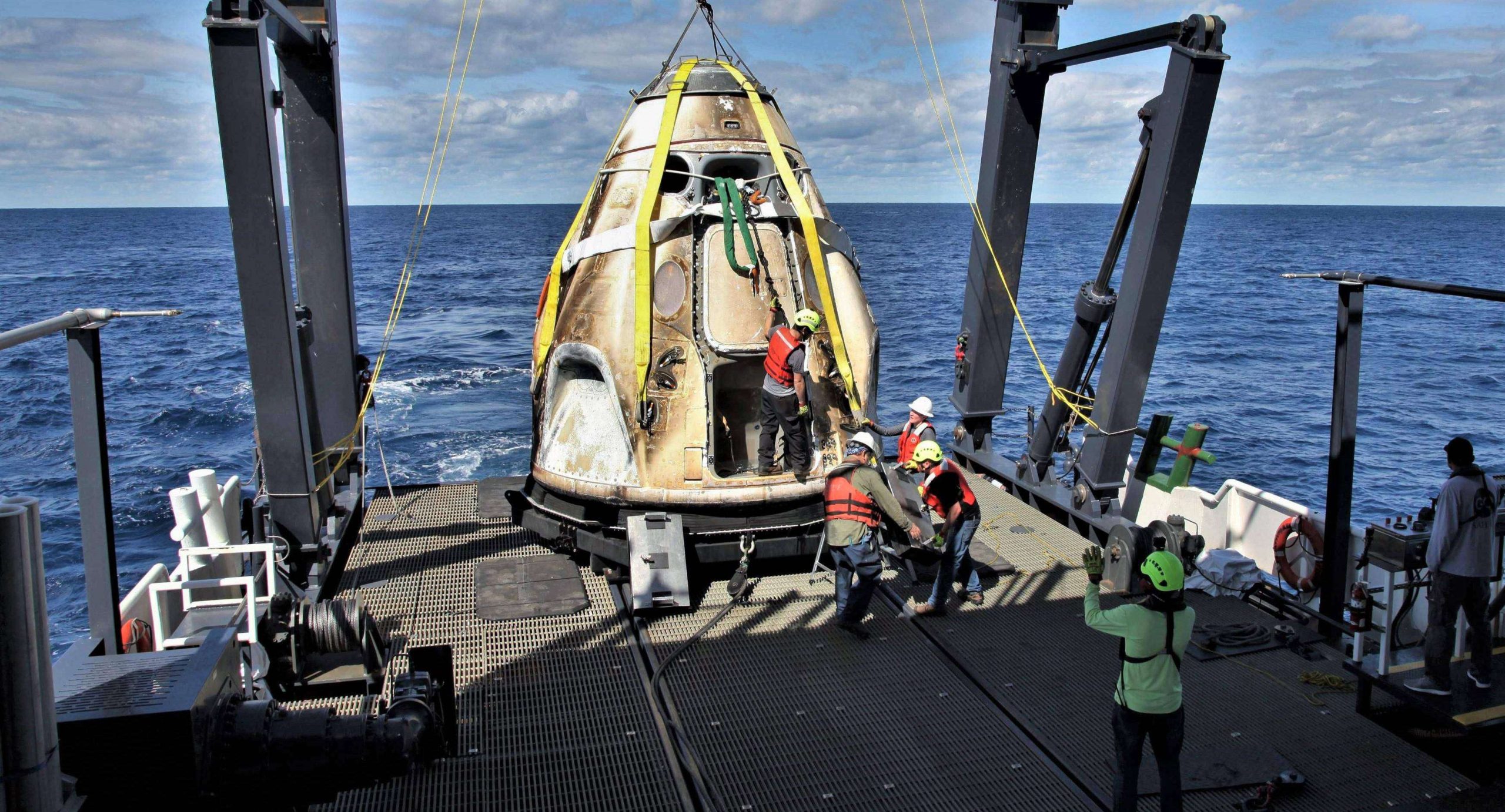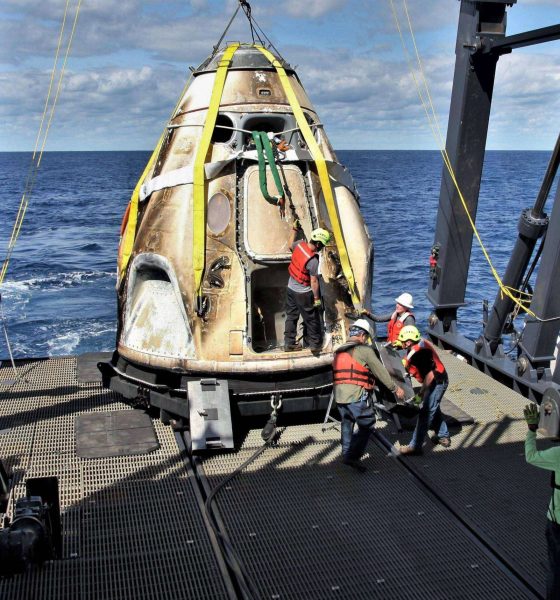

News
SpaceX, NASA win coveted Emmy award for spacecraft launch debut coverage
Over the course of Crew Dragon’s ‘Demo-1’ orbital launch debut, SpaceX and NASA coordinated in a multitude of ways to ensure mission success, including cooperative webcasts that covered nearly all of the spacecraft’s major milestones.
On September 14th, SpaceX and NASA received the 2019 Emmy Award for Outstanding Interactive Program, honoring their combined video, social media, and interactive coverage of Crew Dragon’s inaugural launch, orbital rendezvous, docking, undocking, reentry, and splashdown – a true tour-de-force.
The Crew Dragon Demo-1 mission was a huge step forward for NASA’s Commercial Crew Program (CCP), a public-private partnership between NASA and companies SpaceX and Boeing to build and operate human-rated spacecraft. As the first orbital mission under the CCP umbrella, it successfully demonstrated the viability of NASA and SpaceX’s collaborative approach to fielding a human-rated spacecraft – in this case, an uncrewed Crew Dragon.
The SpaceX-built spacecraft successfully launched atop Falcon 9, rendezvoused and docked with the International Space Station (ISS), hosted a few visits from on-orbit NASA. ESA, and Roscosmos astronauts, and safely reentered Earth’s atmosphere for a soft-landing in the Atlantic Ocean.
NASA and SpaceX teamed up to broadcast the launch, docking, and landing procedures live on YouTube and NASA TV, on top of traditional media on platforms like Twitter, Instagram, and Facebook. NASA explained in a press release that “the nomination is a result of years of preparation for the historic launch and multiple live broadcasts from NASA and SpaceX facilities across the country during each phase of the Crew Dragon’s mission to the International Space Station and its stunning return to Earth. Throughout NASA’s coverage, the agency and SpaceX engaged social media users around the world and at local social media influencer gatherings at NASA’s Kennedy Space Center in Florida.”
SpaceX engineer and broadcast representative – or as she referred to herself, a “talking head that gets to share our science with the world” – Kate Tice used Instagram to express her gratitude for central role in recommunications team and direct the spotlight to NASA astronauts Col. Bob Behnken and Col. Doug Hurley, both of which will fly aboard the first crewed Crew Dragon flight sometime next year.
Several NASA team members – including spokesperson Dan Hout, Administrator Jim Bridenstine, and Communications Director Bettina Inclan – took to Twitter to celebrate the Agency’s win. Bridenstine congratulated all those involved with the “@SpaceX Demo-1 flight, which put us one step closer to our goal of launching @NASA_Astronauts from American soil.”
NASA says that, “selected Creative Arts Emmys will be shown as part of the live 71st Primetime Emmys broadcast on Sept. 22, which will air on Fox at 8 p.m. EDT.”
Check out Teslarati’s newsletters for prompt updates, on-the-ground perspectives, and unique glimpses of SpaceX’s rocket launch and recovery processes.

News
Tesla FSD fleet is nearing 7 billion total miles, including 2.5 billion city miles
As can be seen on Tesla’s official FSD webpage, vehicles equipped with the system have now navigated over 6.99 billion miles.

Tesla’s Full Self-Driving (Supervised) fleet is closing in on almost 7 billion total miles driven, as per data posted by the company on its official FSD webpage.
These figures hint at the massive scale of data fueling Tesla’s rapid FSD improvements, which have been quite notable as of late.
FSD mileage milestones
As can be seen on Tesla’s official FSD webpage, vehicles equipped with the system have now navigated over 6.99 billion miles. Tesla owner and avid FSD tester Whole Mars Catalog also shared a screenshot indicating that from the nearly 7 billion miles traveled by the FSD fleet, more than 2.5 billion miles were driven inside cities.
City miles are particularly valuable for complex urban scenarios like unprotected turns, pedestrian interactions, and traffic lights. This is also the difference-maker for FSD, as only complex solutions, such as Waymo’s self-driving taxis, operate similarly on inner-city streets. And even then, incidents such as the San Francisco blackouts have proven challenging for sensor-rich vehicles like Waymos.
Tesla’s data edge
Tesla has a number of advantages in the autonomous vehicle sector, one of which is the size of its fleet and the number of vehicles training FSD on real-world roads. Tesla’s nearly 7 billion FSD miles then allow the company to roll out updates that make its vehicles behave like they are being driven by experienced drivers, even if they are operating on their own.
So notable are Tesla’s improvements to FSD that NVIDIA Director of Robotics Jim Fan, after experiencing FSD v14, noted that the system is the first AI that passes what he described as a “Physical Turing Test.”
“Despite knowing exactly how robot learning works, I still find it magical watching the steering wheel turn by itself. First it feels surreal, next it becomes routine. Then, like the smartphone, taking it away actively hurts. This is how humanity gets rewired and glued to god-like technologies,” Fan wrote in a post on X.
News
Tesla starts showing how FSD will change lives in Europe
Local officials tested the system on narrow country roads and were impressed by FSD’s smooth, human-like driving, with some calling the service a game-changer for everyday life in areas that are far from urban centers.

Tesla has launched Europe’s first public shuttle service using Full Self-Driving (Supervised) in the rural Eifelkreis Bitburg-Prüm region of Germany, demonstrating how the technology can restore independence and mobility for people who struggle with limited transport options.
Local officials tested the system on narrow country roads and were impressed by FSD’s smooth, human-like driving, with some calling the service a game-changer for everyday life in areas that are far from urban centers.
Officials see real impact on rural residents
Arzfeld Mayor Johannes Kuhl and District Administrator Andreas Kruppert personally tested the Tesla shuttle service. This allowed them to see just how well FSD navigated winding lanes and rural roads confidently. Kruppert said, “Autonomous driving sounds like science fiction to many, but we simply see here that it works totally well in rural regions too.” Kuhl, for his part, also noted that FSD “feels like a very experienced driver.”
The pilot complements the area’s “Citizen Bus” program, which provides on-demand rides for elderly residents who can no longer drive themselves. Tesla Europe shared a video of a demonstration of the service, highlighting how FSD gives people their freedom back, even in places where public transport is not as prevalent.
What the Ministry for Economic Affairs and Transport says
Rhineland-Palatinate’s Minister Daniela Schmitt supported the project, praising the collaboration that made this “first of its kind in Europe” possible. As per the ministry, the rural rollout for the service shows FSD’s potential beyond major cities, and it delivers tangible benefits like grocery runs, doctor visits, and social connections for isolated residents.
“Reliable and flexible mobility is especially vital in rural areas. With the launch of a shuttle service using self-driving vehicles (FSD supervised) by Tesla in the Eifelkreis Bitburg-Prüm, an innovative pilot project is now getting underway that complements local community bus services. It is the first project of its kind in Europe.
“The result is a real gain for rural mobility: greater accessibility, more flexibility and tangible benefits for everyday life. A strong signal for innovation, cooperation and future-oriented mobility beyond urban centers,” the ministry wrote in a LinkedIn post.
News
Tesla China quietly posts Robotaxi-related job listing
Tesla China is currently seeking a Low Voltage Electrical Engineer to work on circuit board design for the company’s autonomous vehicles.

Tesla has posted a new job listing in Shanghai explicitly tied to its Robotaxi program, fueling speculation that the company is preparing to launch its dedicated autonomous ride-hailing service in China.
As noted in the listing, Tesla China is currently seeking a Low Voltage Electrical Engineer to work on circuit board design for the company’s autonomous vehicles.
Robotaxi-specific role
The listing, which was shared on social media platform X by industry watcher @tslaming, suggested that Tesla China is looking to fill the role urgently. The job listing itself specifically mentions that the person hired for the role will be working on the Low Voltage Hardware team, which would design the circuit boards that would serve as the nervous system of the Robotaxi.
Key tasks for the role, as indicated in the job listing, include collaboration with PCB layout, firmware, mechanical, program management, and validation teams, among other responsibilities. The role is based in Shanghai.
China Robotaxi launch
China represents a massive potential market for robotaxis, with its dense urban centers and supportive policies in select cities. Tesla has limited permission to roll out FSD in the country, though despite this, its vehicles have been hailed as among the best in the market when it comes to autonomous features. So far, at least, it appears that China supports Tesla’s FSD and Robotaxi rollout.
This was hinted at in November, when Tesla brought the Cybercab to the 8th China International Import Expo (CIIE) in Shanghai, marking the first time that the autonomous two-seater was brought to the Asia-Pacific region. The vehicle, despite not having a release date in China, received a significant amount of interest among the event’s attendees.








